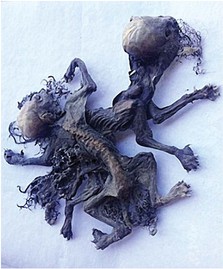
A goat farmer in Chile who found two mysterious dead animals in early January concluded that he may have the remains of the Hispanic vampire beast known as el chupacabra. The creature, whose name is Spanish for “goat sucker,” is said to suck the blood from small animals such as chickens and goats. It has never been proven to exist, though it is nearly as well known as Bigfoot and the Loch Ness monster. According to the January 22 Daily Star, “Goat farmer Javier Prohens was having lunch with friends when terrified farmhand 54-year-old Bricio Saldivar alerted them to the bodies of the strange creatures on the outskirts of the small town of Monte Patria in the east central Chilean province Limari.” Prohens described his farmhand’s reaction: “He was clearly scared and said he had been up at the old winery and found two strange bodies.” The partially mummified carcasses were found amid hay bales in a cellar, and “at first we thought they might be bats, but when we looked closer, we realized they had to be something else as the heads were too big for bats. . . . And then someone said they looked like Chupacabras,” Prohens was quoted as saying.
The chupacabra was first reported in August 1995 by a woman in Puerto Rico who described seeing a bizarre bipedal alien-like creature with spikes down its back. Soon it was dubbed the “chupacabra” and caused a media sensation that spread throughout the Spanish-speaking world. However, as described in my book Tracking the Chupacabra: The Vampire Beast in Fact, Fiction, and Folklore, it was later determined that the eyewitness had actually (and mistakenly) described a monster in the sci-fi thriller Species, which she had recently seen.
Though the original chupacabra report has been discredited, the stories and sightings spread through the media with the monster’s description changing over time. Fewer and fewer people claimed to see the bipedal, spiky-spined monster, and by 2000 it had completely disappeared and was replaced by a variety of four-legged animals left hairless by the skin disease mange. When medical and DNA tests were done on these “chupacabras,” they were revealed to be ordinary animals including dogs, coyotes, and raccoons. Last year, a couple in Ratcliffe, Texas, claimed to have found a chupacabra that turned out to be a raccoon. The word chupacabra is now used to describe any animal that cannot be immediately identified or otherwise looks mysterious, either because of hair loss or decomposition.
Amid all the sensational news stories about these bloodsucking monsters, there has so far been no analysis by zoologists or scientists.